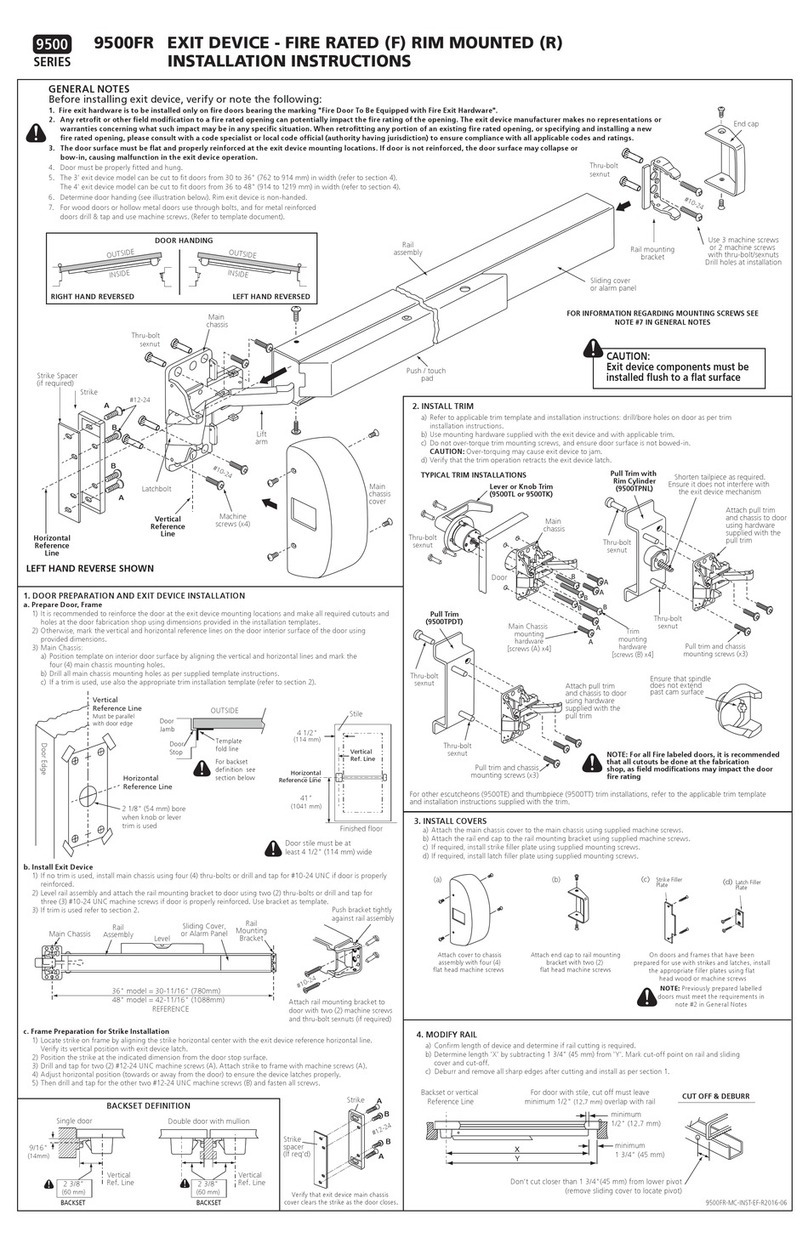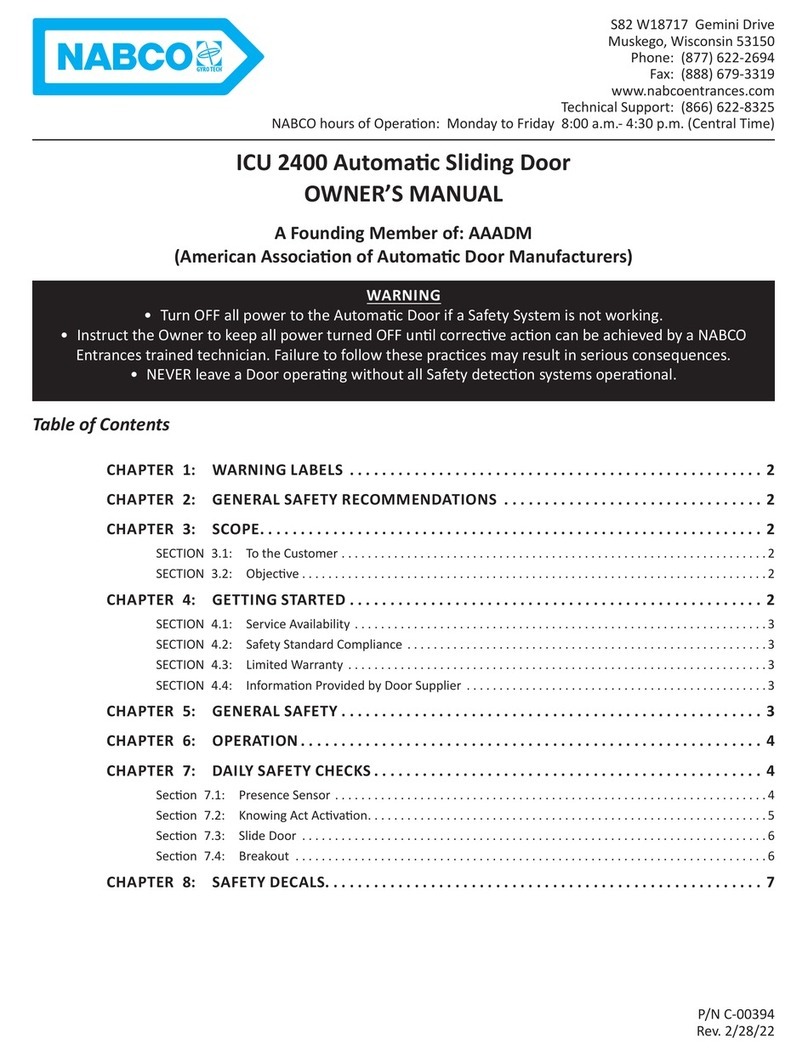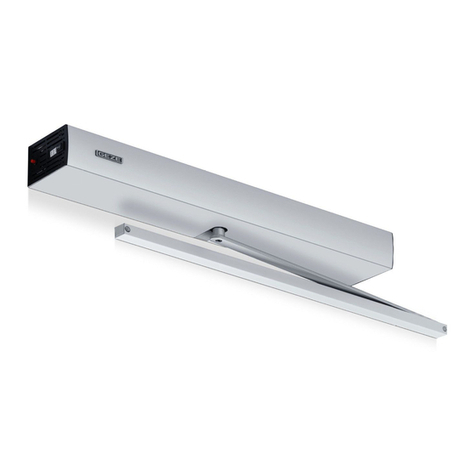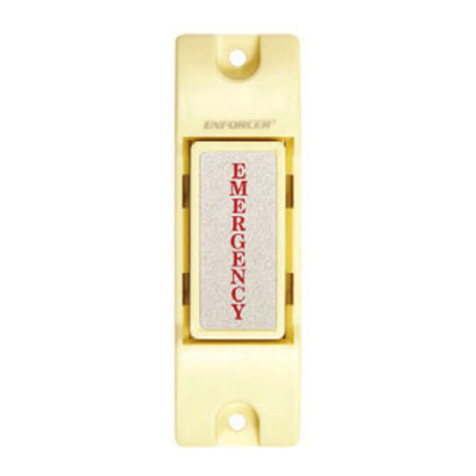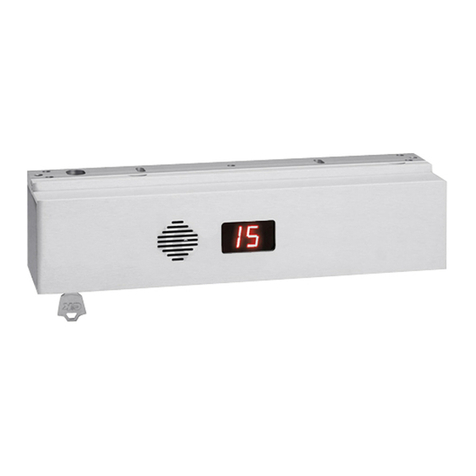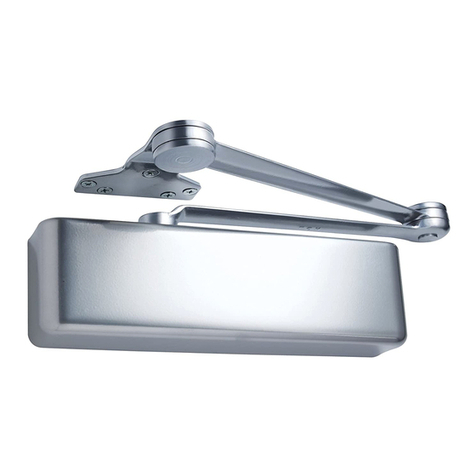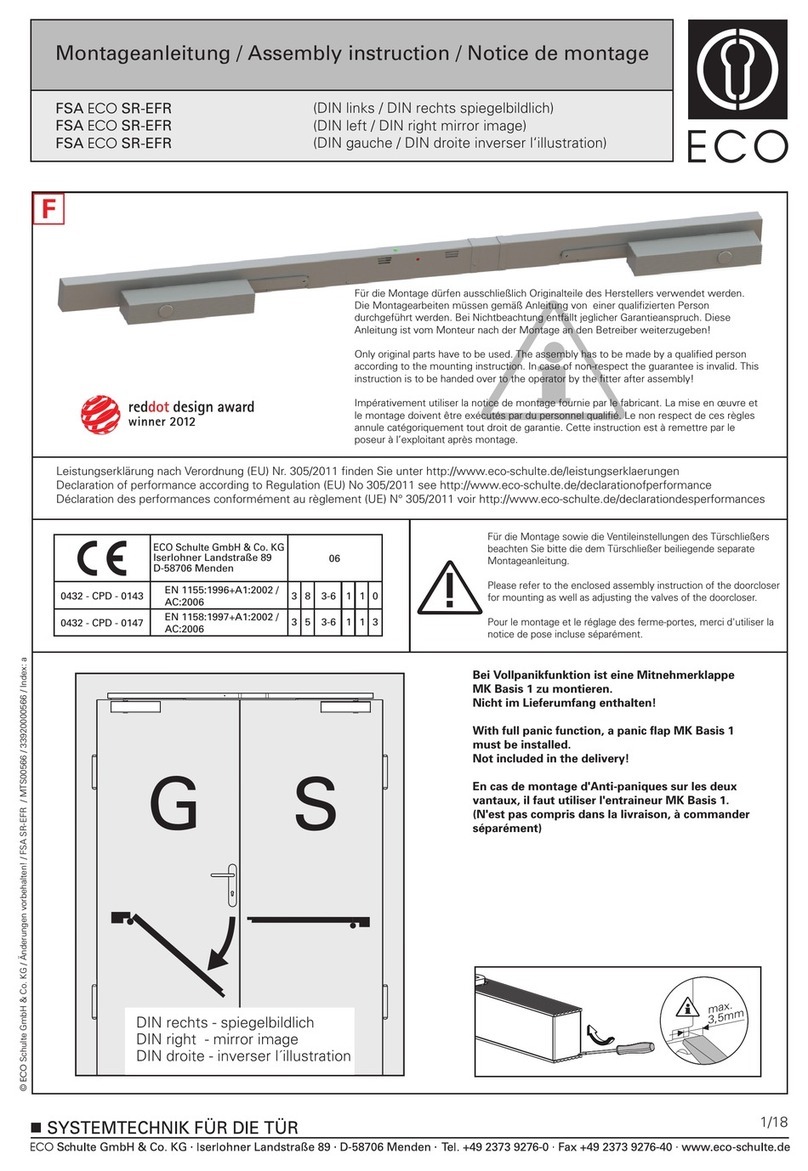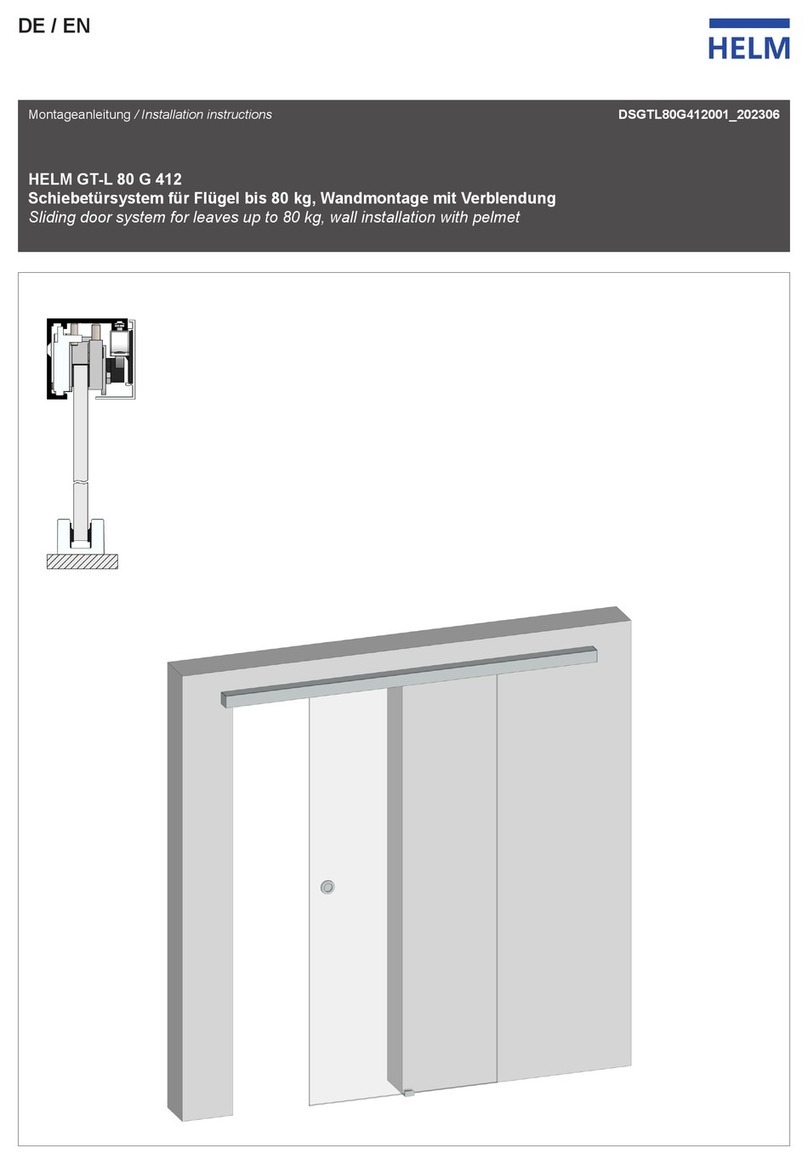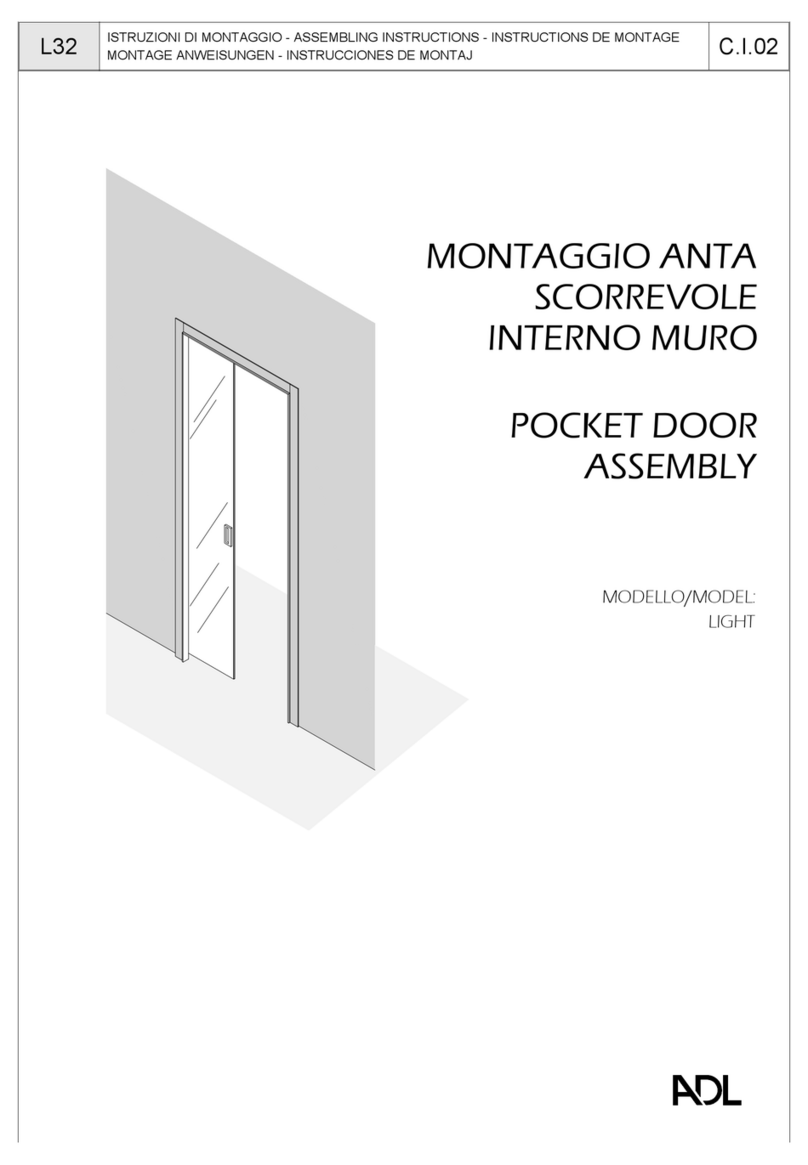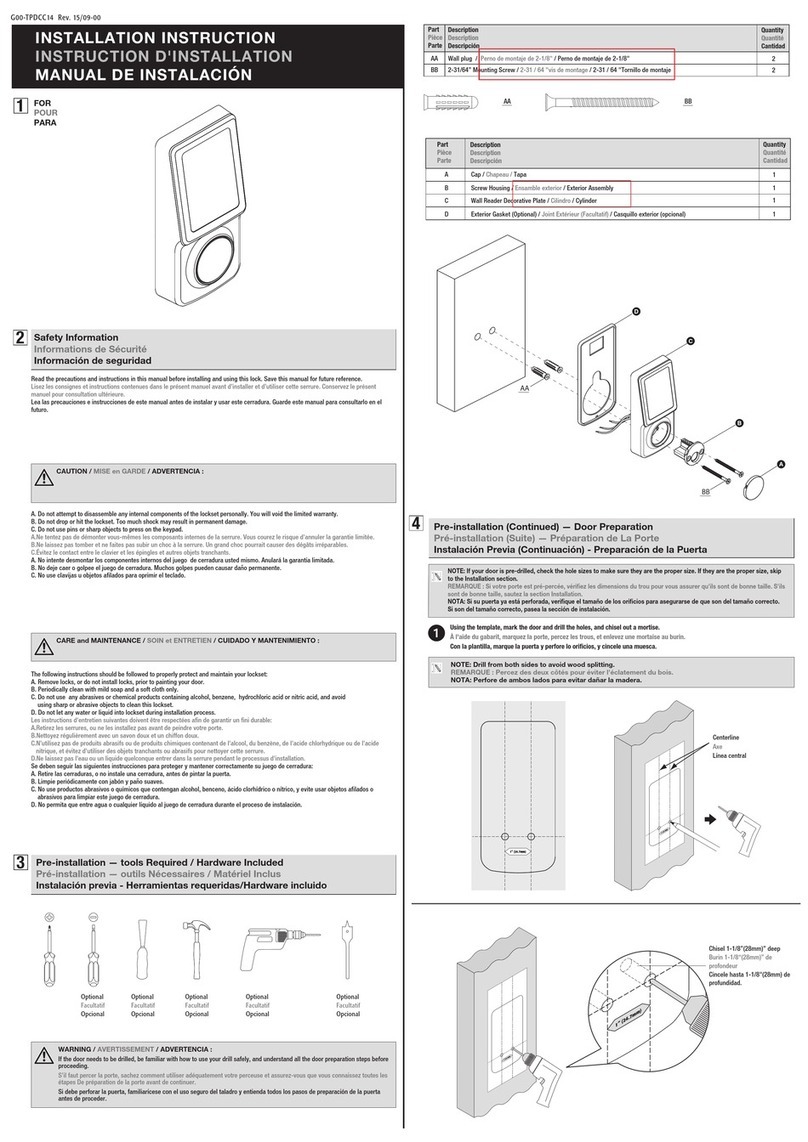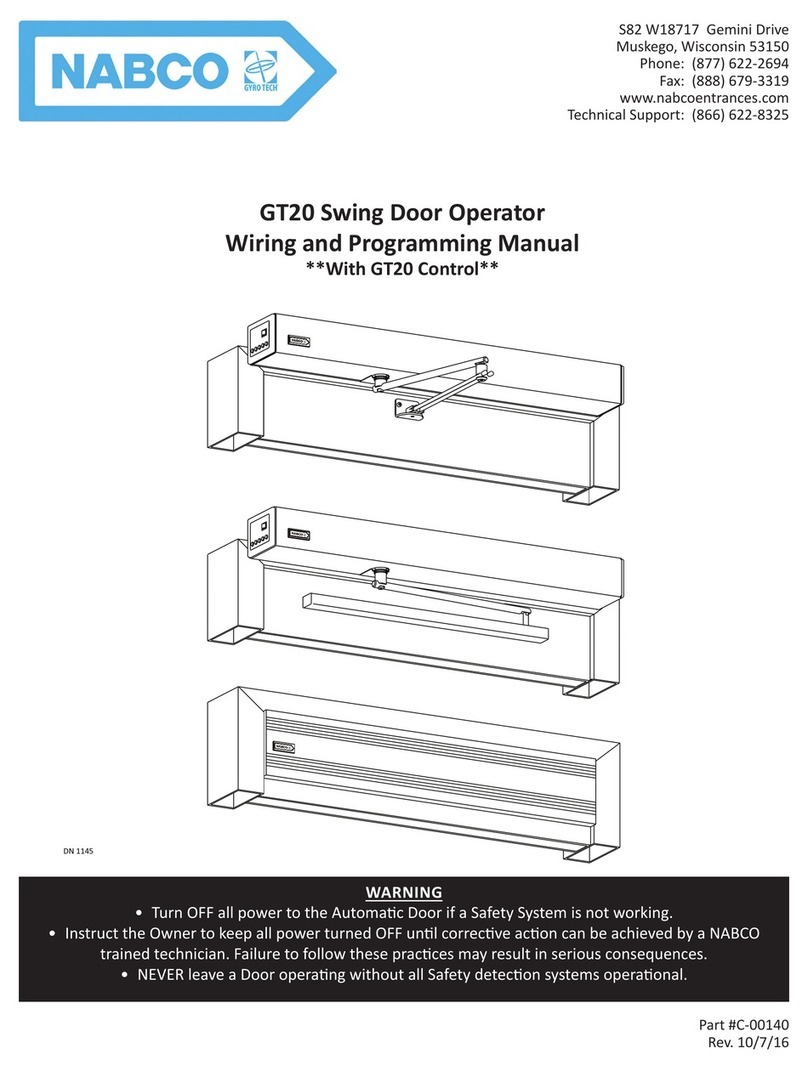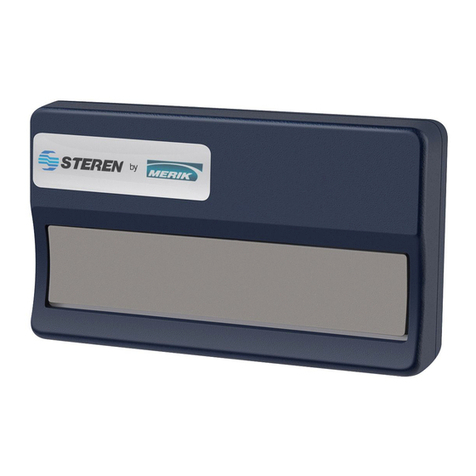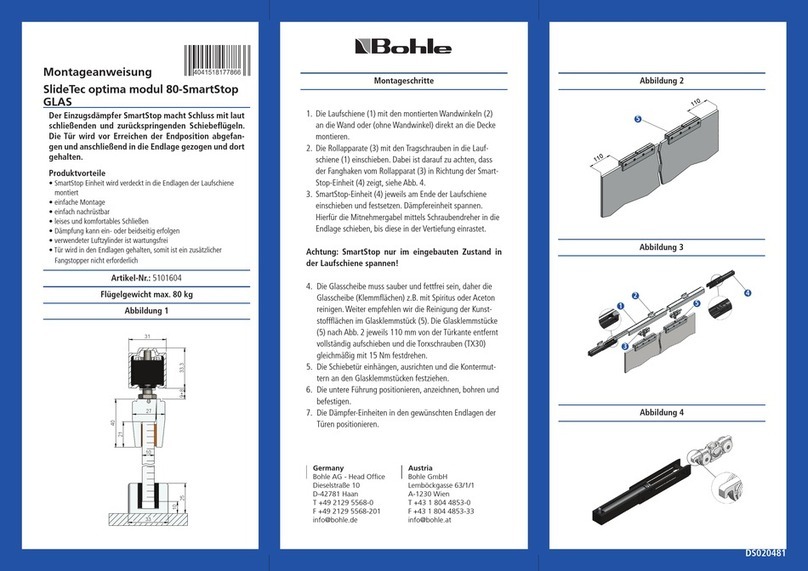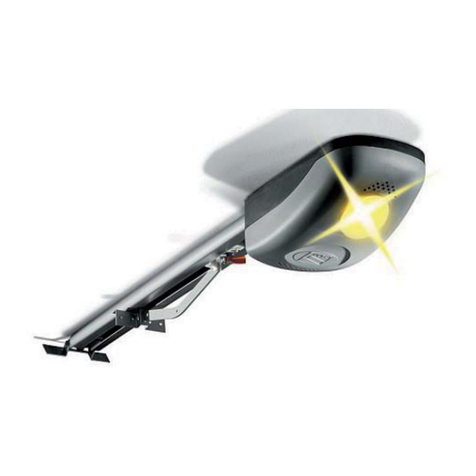Tormax Automatic TORMAX 2201 User manual

T-1165 e 15.3.21
Translation of the original
instructions for use
Instructions for Use
For Automatic Sliding Doors with Drive:
TORMAX 2201 Sliding Door Drive
Safety instructions in chapter 2 must be observed!

2Instructions for Use TORMAX 2201 T-1165 e
First edition: 9.04, Update: 4.12, 3.21
We reserve the right to make technical changes.
Contents
1 General Information 3
2 Safety 4
2.1 Responsibilities 4
2.2 Intended Use 4
2.3 Pre-conditions for the Operation of the System 4
2.4 Hazards and Risks 4
2.5 Checks 5
2.6 Decommissioning the System in the Event of a Fault 5
2.7 Disposal 5
3 Product Description 6
3.1 System Overview 6
3.2 System Function 7
3.3 Operating Modes 8
4 Operation 9
4.1 Commissioning 9
4.2 Operation with the TORMAX User Interface 9
4.3 Operation with an Operating Mode Switch 10
4.4 Operation on Power Failure 10
5 Procedure in the Event of a Fault 11
5.1 Fault indication 11
5.2 Restarting the Door System After a Fault (Software Reset) 11
6 Maintenance 12
6.1 Cleaning 12
6.2 Functional Checks 12
6.3 Maintenance and Testing 12
7 Appendix 13
7.1 Fault Table 13
7.2 Check-list for Functional Checks 14
Declaration of Conformity 15

Instructions for Use TORMAX 2201 T-1165 e 3
1 General Information
Target Groups
• Operator of the automatic sliding door. The operator is the person responsible for the operation and
maintenance of the system.
• Persons instructed by the operator to carry out certain duties, for example the servicing and maintenance
of the automatic sliding door.
Area of Application
Product name, door system: Automatic sliding door
Product name, door drive: TORMAX 2201 Sliding Door Drive
Identification plate: The identification plate with the serial number is attached to the header section.
<
Explanation of the Symbols
The Warning message warns about possible risk of injury.
Text which is highlighted in grey MUST be observed to ensure that the system operates perfectly.
Failure to observe these sections can cause damage to equipment.
Functions marked with this symbol are the factory setting. However, they can be reprogrammed
by a skilled person.
Optional components which are not present in all systems.
Technical Data
Drive type Electro-mechanical sliding door drive with DC motor
Control system Control unit 2201 MCU8-CONU-85-B
Mains connection 1 x 230 V AC, 10 – 16 A / 1 x 115 V AC, 15 – 20 A, 50 – 60Hz
Power consumption max. 200 W
Motor 24 V DC, 4,9 A
Sensor supply 24 V DC, 1 A
Protective class, drive IP 22
Ambient temperature – 20 °C to +50 °C
Noise emission level < 70 db (A)

4Instructions for Use TORMAX 2201 T-1165 e
2 Safety
2.1 Responsibilities
For instructing the operator: A skilled person from a TORMAX sales partner
For operating the system: The operator or a person instructed by the operator
For maintenance and function control: The operator or a person instructed by the operator
For annual testing and approval: A skilled person authorised by the manufacturer
Skilled persons are persons who have adequate knowledge in the field of power-operated doors as a
result of their specialist training and experience and who are so familiar with the relevant health and
safety regulations, guide-lines and generally recognised codes of practice that they are able to assess the
condition of power-operated doors with regard to the safety of their operation.
Maintenance of electrical parts must be carried out by a trained electrician.
2.2 Intended Use
The automatic sliding door is intended exclusively for use in dry premises in areas used as a pedestrian
thoroughfare. The manufacturer will not accept any liability whatsoever for loss or damage caused by
improper use, failure to comply with the maintenance specification (see section 6) or unauthorised modi-
fication of the system.
2.3 Pre-conditions for the Operation of the System
The door system was designed, installed and checked for functionality and safety by skilled persons prior
to hand-over to the operator. The company responsible for the system’s installation instructed the operator
on the system’s use and maintenance as well dangers associated with the system operation. The opera-
tor has confirmed this by his signature in the system test book T-879.
The provisions imposed by law, health and safety and occupational health regulations for the avoidance
of accidents and the protection of the environment which are generally applicable in the country in which
the system is operated supplement the Instructions for use.
• Read the Instructions for use carefully before commissioning the automatic sliding door.
• Only use the system when it is in perfect working order. The operating conditions, inspection and
maintenance intervals stipulated by the manufacturer must be observed (section 6).
• Safety facilities (e.g. sensor technology, manual unlocking) must not be removed or disabled.
• Arrange to have any faults rectified immediately by a skilled person.
2.4 Hazards and Risks
Depending on the system design and equipment, there is a residual risk of crushing, entanglement and
collision in the movement area of the door leaves – albeit with restricted force.

Instructions for Use TORMAX 2201 T-1165 e 5
Hazards can arise:
– in the region of the secondary closing edges
– door guides in the floor
– in the split in the cladding for suspending the door
– if objects, for example sales stands, are erected in direct proximity to the operating range of the door
leaves.
– due to deliberate damage by vandals, defective sensors or sensors which are no longer properly ad-
justed, sharp edges, incorrectly supported and defective casing or missing covers.
2.5 Checks
The regular checks and examinations set out in Chapter 6 must be carried out as instructed by the manu-
facturer. The manufacturer recommends that a maintenance contract be concluded in order to operate the
system safely and to maintain its value for as long as possible.
2.6 Decommissioning the System in the Event of a Fault
If there is a fault the automatic door may only be taken out of service by a skilled person, the operator or
a person who is instructed to do so by the operator. This must be done on all occasions on which the
safety of persons could be compromised.
• Disconnect the system from the power supply.
• Select operating mode Manual Operation, if the system continues to operate using the internal emer-
gency power supply (see section 4.2 for switching to manual operation).
• Open the door manually and leave open if it is installed in an escape route.
See section 7 for rectification of faults.
2.7 Disposal
This system must be properly dismantled at the end of its working life. Its disposal must comply with na-
tional regulations. We recommend that you contact a skilled person disposal company.
– Aggressive acids.
– Risk of injury if you dismantle the battery module.
– Dispose of batteries properly.
– Airborne parts.
– Risk of injury when dismantling the rubber cord suspension.
– Take care when releasing the tension on the rubber cord.
– Broken glass.
– Risk of injury when dismantling the door leaves.
– Take care when transporting the door leaves.

6Instructions for Use TORMAX 2201 T-1165 e
3 Product Description
3.1 System Overview
1 Drive Cladding
Motor unit
MCU8 control system with monitoring system, power limitation and permanent
diagnosis
Guide system with noise-absorbent guide rail
2Drive accessories u£Lock with
a) £internal manual activation £in the cladding £on the wall
b) £external manual activation
£Emergency power supply via the battery unit
£Mechanical emergency opening
3 Door leaves a) Moving leaves with main closing edge (HK) and secondary closing edge (NK)
b) Moving leaves with floor guide
c) £Side part u
d) £Protection leaves uas protection for the secondary closing edge
4Operating controls ua) £User interface with 6 operating modes and fault indication
b) £Operating mode switch with 3 positions.
c) £Lock for the user interface
d) £Remote control of operating modes
5Internal activators a) With automatic activation b) With manual activation
£Radar with/without direction recognition £Push button
£IR motion detector £Contact-free button
6External activators a) With automatic activation b) With manual activation
£Radar with/without direction recognition £Key switch
£IR motion detector £Card reader
£Remote control
7Safety sensors a) £Presence sensor: main closing edge protection
b) £Presence sensor, external: main closing edge protection
c) £Safety beams
d) £Presence sensors: secondary closing edge protection
8Emergency systems a) £Power switch / fuse
b) £Emergency on/off switch
c) £Fire alarm system
9Output message u£Bell / gong £Light / ventilation £Door locked
£Door status ………………
£Depending on the system’s equipment
T1321_4e
3c 3a 3a
HK
inside outside
NK NK
5a, 7a
3d
3c
3d
3b 3b
1
4a
4c
8b
7c
7b 6a
6b
2a 4d 4b
8c
7d 7d
2a
8a
2b

Instructions for Use TORMAX 2201 T-1165 e 7
3.2 System Function
It is the responsibility of the system operator to ensure that the automatic sliding door can be freely
used at all times and particularly that access to the sliding door is not blocked.
Automatic Door Operation with Sensors
When operating automatically (AUTOMATIC operating mode) the door is automatically opened from both
sides by sensors when a person approaches.
A key switch uor card reader unormally allows access from outside when the door is in operating mode
EXIT or OFF. The door unlocks, opens and closes again as soon as no further sensors are activated after
a hold-open time which is set separately.
The sensors for the door opening and the maintained opening of the door are arranged and adjusted in
such a way that the door opens promptly and remains open as long as a person is within the operating
range of the door leaves. The door can close nevertheless but only after an attendance time of approx.
> 1 minute.
The reduced closing speed which is set by the installer and is adjusted in line with the door weight, com-
bined with a force of < 150 N prevents the impact of the moving leaves on a person from being too severe.
The obstruction is also detected by the control system and the door automatically reverses.
Traffic Control
Movement through the door can be allowed in only one direction if desired (operating mode EXIT) or
completely blocked (operating mode OFF).
In order to protect against environmental influences (e.g. wind / cold / heat) operating mode AUTORED
can be used to operate the door with a narrower opening width of at least escape route width.
Automatic System Monitoring
The control system monitors the safety sensors by a cycle of active tests. The control system also conducts
continuous internal system tests. If a safety-related component should fail, the system automatically
switches into a safe condition. At the same time the fault number is displayed on the user interface. You
can find further information on this subject in section 5 “Procedure in the Event of Faults”.
Electro-mechanical Lock u
The system can be locked in the closed position by means of an electro-mechanical lock u or held in the
closed position by a holding magnet uwhen in operating mode OFF and, if required, in other operating
modes (e.g. EXIT).
The locking process is monitored. Thus any fault of the locking operation can be immediately displayed
on the user interface. See section 5 “Procedure in the Event of Faults” for details.
In the event of a power failure the locks can also be directly activated by the optional manual facility.
Operation in the Event of a Power Failure
Depending on the equipment installed, the following functions are possible:
– Immediate emergency opening or closing by a mechanical energy store system.
T1321_12

8Instructions for Use TORMAX 2201 T-1165 e
– Continued operation of the system by means of a battery unit ufor a specific time with the doors open-
ing before the battery switches off. The door remains locked in operating mode OFF.
– Unlocking and opening of the door from outside by means of a key switch and the battery unit u.
3.3 Operating Modes
By using the TORMAX user interface uit is possible to operate the automatic door system in 6 operating
modes and with status displays or to use a simple operating mode switch uto operate the door in 3 op-
erating modes.
Operating Mode OFF
The internal and external sensors are disregarded. The door is maintained in the closed position either by
the motor or the holding magnet uand/or locked by the electro-mechanical lock u. Access is only pos-
sible using the key switch u.
<The door can still be used for 10 seconds after selecting operating mode OFF. The transition is signalled
on the user interface by the flashing display of operating mode OFF.
Operating Mode AUTO
The operating mode AUTO is normally used during the day. The door opens automatically to its full open-
ing width to both sides by means of the internal and external sensors.
Operating Mode AUTORED
Operating mode AUTORED is normally used for daytime operations. The door opens automatically with
a reduced opening width to both sides by means of the internal and external sensors.
<If required, the opening width can be altered by the installer.
Operating Mode EXIT
Operating mode EXIT is normally used for the period before the shop or office closes. The door will only
open automatically when activated by the internal sensor.
When the door opens the external sensor is also monitored for safety reasons.
The opening width is determined by previously selecting operating mode AUTO or AUTORED. The door can
be automatically blocked using the holding magnet u.
Operating Mode OPEN
The door opens and remains open. The opening width is determined by the prior selection of operating
mode AUTO or AUTORED.
Operating Mode Manual Operation
The door leaves can be freely moved. This operating mode can be used for cleaning the door leaves and
the floor guide or for temporarily shutting down the door. The system is reset after leaving this operating
mode.

Instructions for Use TORMAX 2201 T-1165 e 9
4 Operation
The automatic sliding door may only be operated by a skilled person, the operator or a person instructed
by the operator.
4.1 Commissioning
Before switching on the mains power supply:
• Unlock the optional mechanical door lock e.g. floor lock.
• Check that the movement area of the door leaves is free from objects e.g. umbrella stands or vehicles.
• Check that the floor guide (particularly if it is continuous) is clean and not blocked by anything (e.g.
gravel or snow).
• Switch on the mains power supply and select operating mode AUTO, for example.
• Wait until the door is closed.
The first movement after switching the power on for the first time is slow. The control system is
checking the door leaf’s travel distance and defining the end position.
The door is now ready for operation.
4.2 Operation with the TORMAX User Interface u
TORMAX User Interface Lock ufor User Interface
Selection of Operating Modes
• Release lock ufor user interface.
• Press selector key briefly. The corresponding operating mode symbol is illuminated.
Switching to manual operation
• Press the selector key and hold down for 5 seconds.
Manual operation is indicated by all five LEDs flashing.
• Press the selector key briefly to switch out of manual mode.
Fault indication
e.g. LED 4 flashes. See Section 5 for how to proceed in the event of faults and how to reset the system.
See chapter 7 for the definition of the fault.
Operating mode
T1165_1e
LED
Selector key
OFF
AUTO
AUTORED
OPEN
EXIT
www.tormax.com
1
2
3
4
1
1
0
T1427_4

10 Instructions for Use TORMAX 2201 T-1165 e
4.3 Operation with an Operating Mode Switch u
Selection of Operating Modes
The operating mode can be set directly.
4.4 Operation on Power Failure
Manual Locking u
• Press the manual operation knob inwards.
• Push the door closed by hand until the latch engages.
OFF
AUTO
OPEN
Manual Unlocking u
• Pull the manual operation knob outwards.
• Push the door open by hand.
Opening a Door with a Battery Unit uUsing a Key Switch u
• Turn the key switch to the “on” position and hold in place for at least 5 seconds, then turn the key to
the original position.
The key switch must not remain permanently in the “on” opposition.
The battery is activated using the “wake up” function.
The door is unlocked, opens, closes slowly and locks again.
The battery switches off automatically again after 90 seconds.
T1166_13
T1305_4

Instructions for Use TORMAX 2201 T-1165 e 11
5 Procedure in the Event of a Fault
Faults are evident through unusual behaviour by the door and/or are indicated by the flashing light-emitting
diodes (LEDs). The display takes the form of either a single flashing LED or by ”Manual operation“ being
indicated if the system was automatically shut down by the control unit or an emergency opening was
triggered. In this case the fault number is indicated by the single LED that is not illuminated.
5.1 Fault indication
See the table in Section 7.1 for a summary of fault signals and possible means of rectification.
Example: Display of fault number 3
5.2 Restarting the Door System After a Fault (Software Reset)
Reset after a fault with the TORMAX user interface
Occasional faults can be rectified by re-starting the system.
• Press selector button 5 and hold down for 5 seconds – the software is reset.
Resetting after fault number 5
• Press selector key briefly
• Change operating mode
• Turn the key switch on and then
off again quickly
Reset of the Fault by Disconnecting the Power Supply
• If the system does not have a battery unit, disconnect from the power supply for about 10 seconds.
If this does not reset the fault or if it re-occurs after a short time, you must arrange for the fault to be rec-
tified by a skilled person from your TORMAX dealer. In this case note the fault number and inform the
dealer. See the last page or the service tag on the system for the dealer’s address.
T1165_12
LED T1165_14
LED
LED 3 flashes
All except LED 3 are
flashing – The door
system is in MANUAL
OPERATION because
of fault number 3
T1165_17
LED
All except LED 5 are
flashing – The door
system is in MANUAL
OPERATION because
of fault number 5
Example: Display of fault number 5
or
www.tormax.com
1
2
3
4
1
1
0
T1427_4
The software is reset
manual operation is reset;
the door opens and closes slowly.
T1305_4

12 Instructions for Use TORMAX 2201 T-1165 e
6 Maintenance
The system was tested and approved by an expert before initial commissioning. The manufacturer recom-
mends that you conclude a service contract in order to maintain the value of your system for as long as
possible as well as to ensure the system operates reliably and safely for a long time.
Only genuine TORMAX spare part should be used. The manufacturer accepts no liability if you fail to
observe this requirement.
The following maintenance work must be carried out:
6.1 Cleaning
– Closing doors can crush – danger!
– Trapped limbs can lead to serious injury.
– The system must only be cleaned in operating mode OFF, OPEN or Manual Operation.
• Clean casing parts, the user interface and door leaves with a damp cloth and a commercial cleaner.
• Remove dirt from the floor guide and clean with a damp cloth.
6.2 Functional Checks
The operator must check the function and safety devices of the automatic sliding door at least every
3 months. This will ensure that faults or hazardous changes in the system are detected at an early
stage. See section 7.2 “Check-list for Functional Checks” for items to be checked.
You should arrange for any defects detected during the routine checks to be rectified immediately by a
TORMAX dealer (see the last page of this Manual for the address).
– Potential switching malfunction in the automatic sliding door.
– Potential hazards – injury caused by impact or crushing.
– Do not use any part of your body for functional checks. Use a suitable object (e.g. styro-
foam or cardboard) instead.
6.3 Maintenance and Testing
Maintenance and testing should only be carried out by a trained skilled person following the manufacturer’s
instructions.
Maintenance Interval
The maintenance interval depends on the frequency of use but the system must be maintained at least
once per year.
Scope of the Maintenance Work
The content of the maintenance work is specified by the manufacturer in an inspection list.
System Test Book
The test findings are recorded after the test in the system test book. The operator must keep it in a safe
place.

Instructions for Use TORMAX 2201 T-1165 e 13
7 Appendix
7.1 Fault Table
LED Group of faults Behaviour Cause Trouble shooting
1 Lock • Door does not lock.
• Door does not unlock
and stays closed.
• Lock latch stuck or de-
fective.
• Move lock latch manu-
ally. Free manual disen-
gagement by turning
button ccw for about
90 °.
• If no success, or fault
occurs repeatedly call
TORMAX service.
2 Interface RS232
to user interface
• Operating mode can-
not be changed.
• No display on the user
interface.
• Connection from the
control unit to the user
interface interrupted
• Call TORMAX service.
3 Safety facility • Door remains open
or
• Door stops at the ob-
stacle and leaves can
be moved freely.
• Safety sensor has
been active for more
than 5 min, or safety
test is negative.
• Reversing has been
triggered 5 times in a
row.
• Remove objects in the
door passage.
• If no success, or fault
occurs repeatedly call
TORMAX service.
4 Activators • Door remains open. • Activator inside/out-
side or key switch has
been active for more
than 5 min.
• Reset key switch.
• If no success, or fault
occurs repeatedly call
TORMAX service.
5 System • Door stops and leaves
can be moved freely.
• Internal system fault. • Change operating
mode (= RESET).
• Activate key switch
briefly.
• If no success, or fault
occurs repeatedly call
TORMAX service.
All No fault • Door stops and leaves
can be moved freely.
• Operating mode
MANUAL
• Change operating mode
No dis-
play
• No reaction of the
door and leaves can
be moved freely.
• Mains supply interrupt-
ed.
• Emergency power sup-
ply switched off.
• Drive is overheated.
• Switch on mains
➞main fuse
• Wait for 15 min. till drive
has cooled down.
• If no success, call
TORMAX service.

14 Instructions for Use TORMAX 2201 T-1165 e
7.2 Check-list for Functional Checks
Item To Be Checked Procedure Resultat
Sensors
T1321_7
• Walk through the door direct-
ly from the front and from dif-
ferent directions at normal
speed, starting both from the
inside and outside
The door opens at the right time
and with sufficient speed so that
passage through the door Is not
hindered.
Safety Sensors
T1321_7
• Walk through the door direct-
ly from the front and from dif-
ferent directions at a slow
speed like an infirm person,
starting both from the inside
and outside.
The door opens and remains
open until you are completely
through the door.
Moving Leaves, Side Parts, Fixed Leaves
• Check the glass door fillings,
door edges and rubber pro-
files for damage.
The door fillings have no sharp
edges and splintered glass.
The side parts and the door
seals are in place and undam-
aged.
Guide System and Door Guides
T1321_2
• Check the noises made
while the door moves.
No unusual and noticeable
movement noises can be heard
in the drive, guide system or
floor guides.
Cladding
iMotion 2301 / 2401 iMotion 2202
• Check whether the cladding
is correctly slotted into place
and secured.
The cladding is firmly slotted
into place.
Operating Controls
3
• Check the function and
marking of operating con-
trols.
The operating controls are func-
tioning correctly; the markings
are visible and legible.
System Vicinity
T1321_12
• Check access to the door
and the movement area of
the door leaves.
Access to the door is free from
objects and items likely to cause
the user to trip. There are no
objects such as shelves, plant
containers and umbrella stands
within a radius of 50 cm of the
movement area.

Instructions for Use TORMAX 2201 T-1165 e 15
T-1063 e Declaration of Conformity
EC Declaration of Conformity
The manufacturer (installation company) of the complete door system declares
Manufacturer’s address:
that the product (door system)
Type designation:
Serial number:
is in conformity with the directive 2006/42/EC (Machinery Directive)
is in conformity with regulations of the guidelines:
- 2014/35/EU (low tension)
- 2014/30/EU (electro-magnetic-compatibility)
and the following harmonised standards have been adhered to:
- EN 16005
Base document:
- Declaration of incorporation by TORMAX | LANDERT Group AG
- Risk evaluation for automatic sliding doors | T-1178
Person responsible for documents
Name/address:
Place, date:
Signatory
(CE authorized person):
Signature:

420377
TORMAX Swing Door Drives
TORMAX Sliding Door Drives
TORMAX Folding Door Drives
TORMAX Revolving Door Drives
the passion to drive doors
Producer Installation company (installation, repairs,service)
TORMAX
Unterweg 14
CH-8180 Bülach-Zürich
Phone +41 58 500 5000
Fax +41 58 500 5099
www.tormax.com
TORMAX is a Division and a registered trademark of LANDERT Group AG
Table of contents
Other Tormax Automatic Door Opening System manuals

Tormax Automatic
Tormax Automatic T-1165 Operating instructions
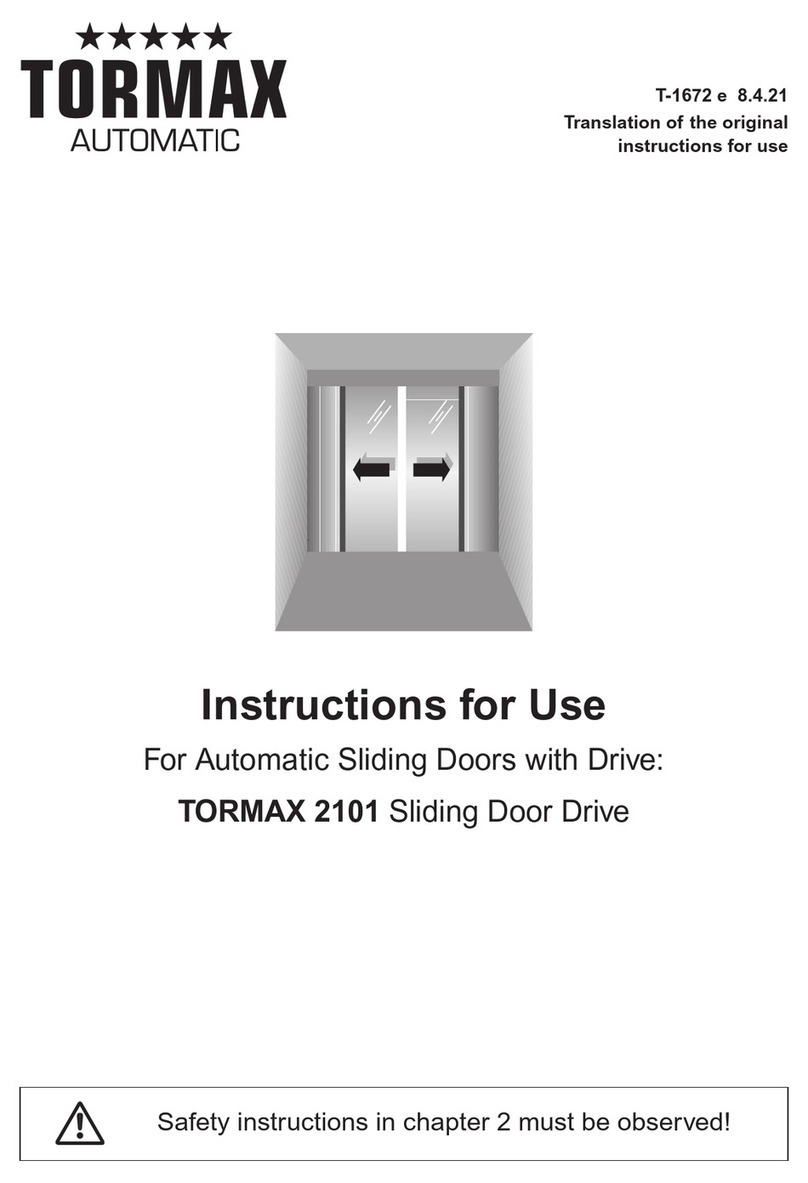
Tormax Automatic
Tormax Automatic 2101 User manual
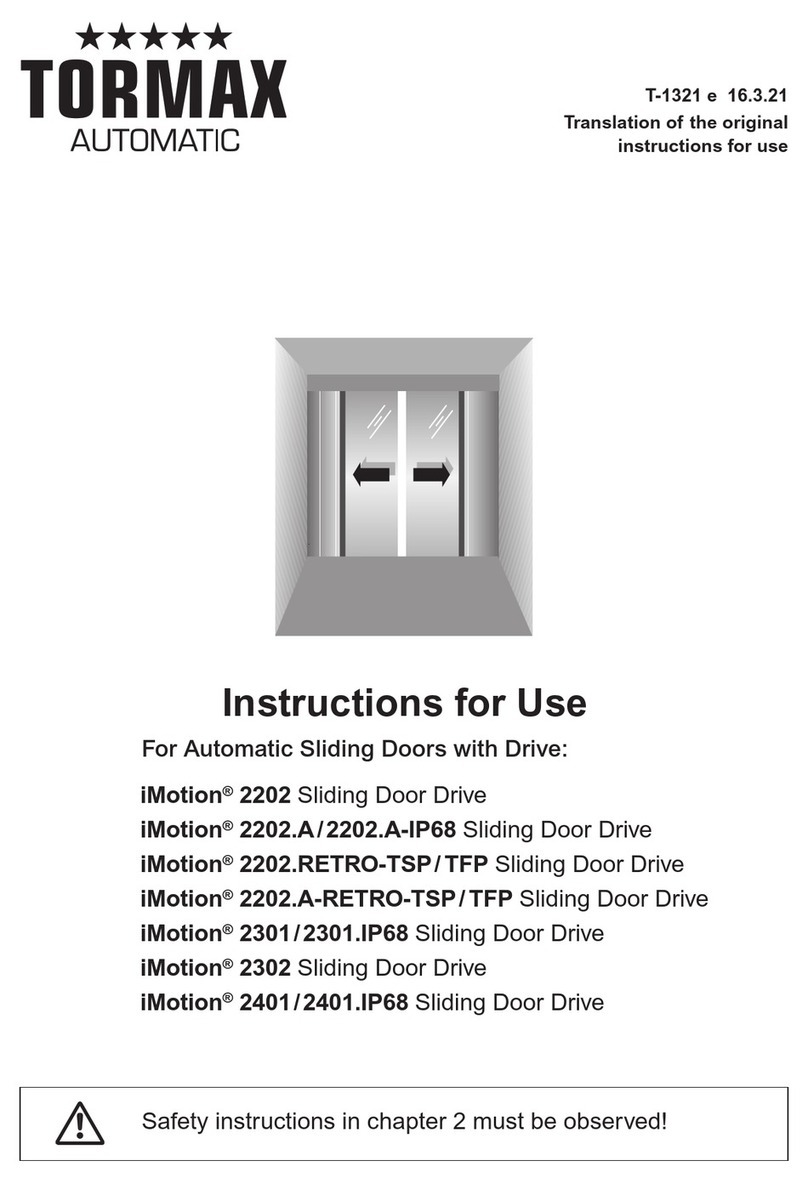
Tormax Automatic
Tormax Automatic iMotion 2202 User manual
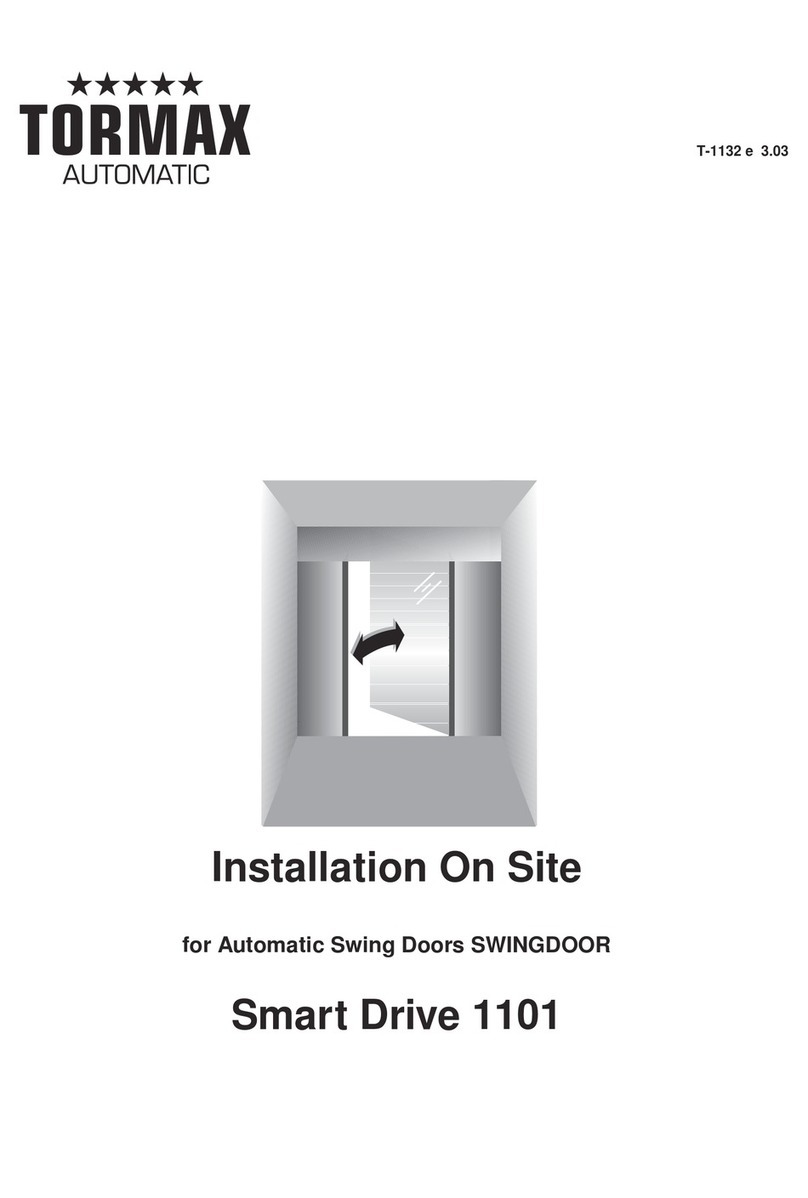
Tormax Automatic
Tormax Automatic Smart Drive 1101 User manual
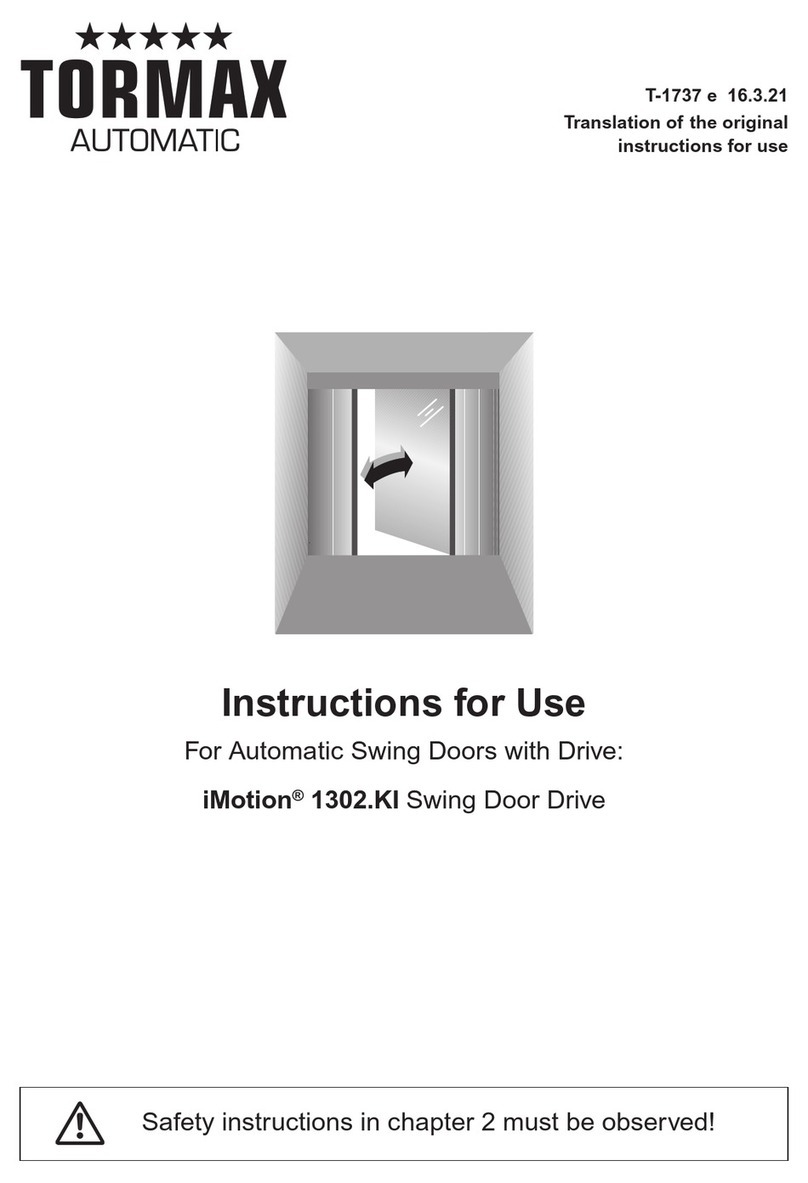
Tormax Automatic
Tormax Automatic iMotion 1302.KI User manual
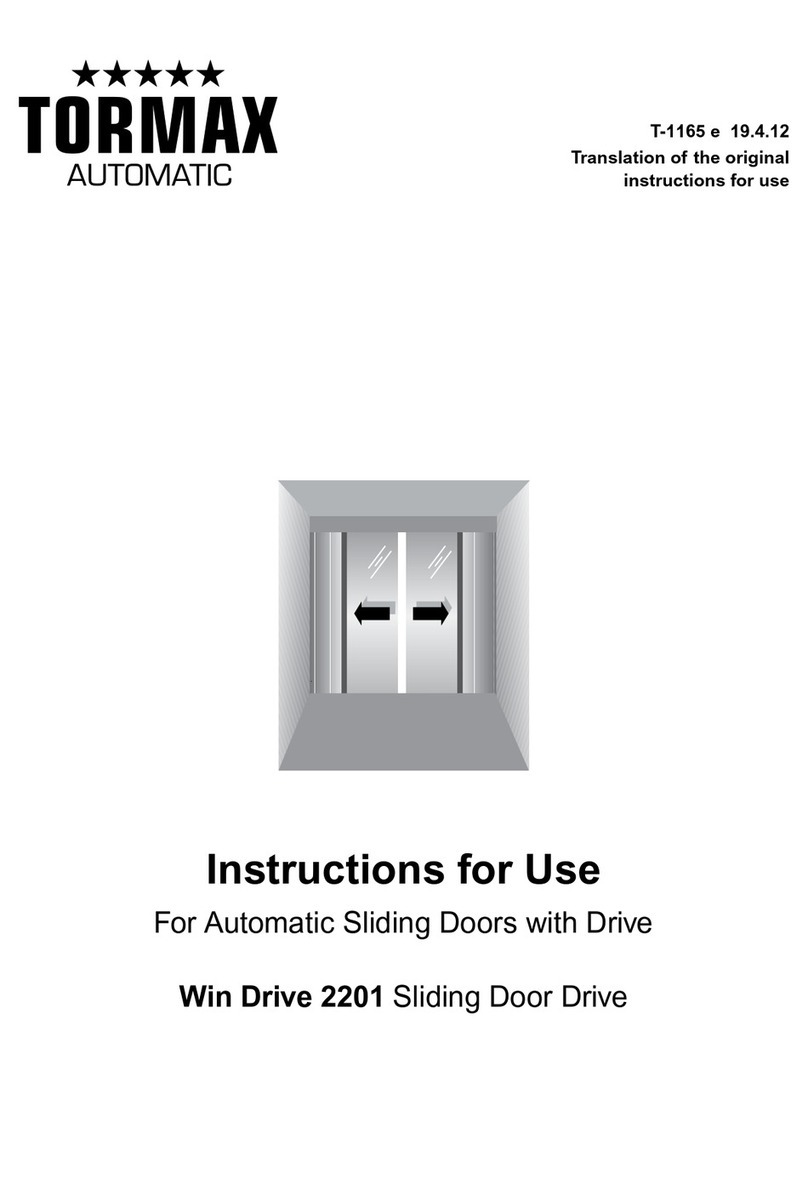
Tormax Automatic
Tormax Automatic Win Drive 2201 User manual
